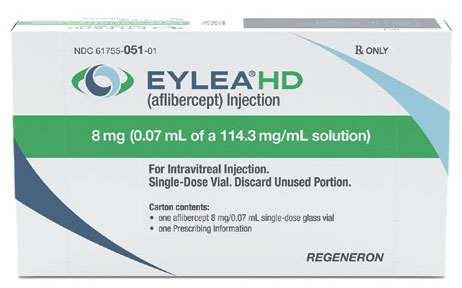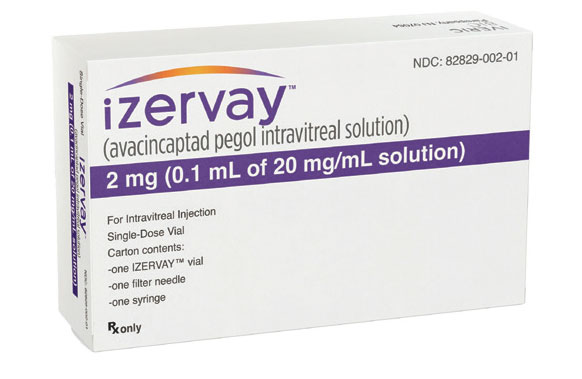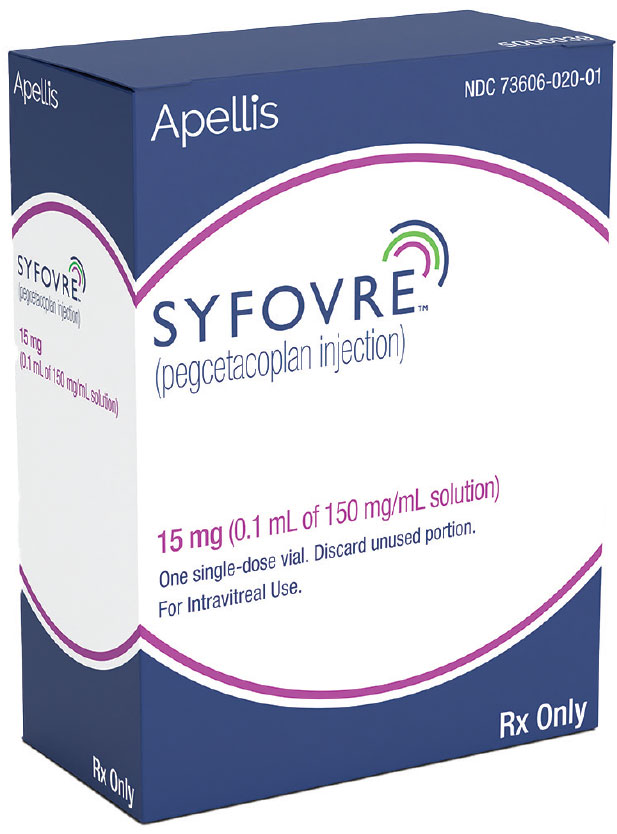1. Aflibercept 8 mg seeks its place in the retina specialist’s tool chest
 |
With the FDA approval of aflibercept 8 mg (Eylea HD, Regeneron Pharmaceuticals) for three indications in retina—neovascular age-related macular degeneration, diabetic macular edema and diabetic retinopathy—retina specialists have a new option for longer-term treatment intervals. The label recommendation for nAMD and DME is eight to 16 weeks after three monthly loading doses, and, for DR, eight to 12 weeks after the loading doses.
While Eylea HD has the potential to address issues patients have coming into the office every month or every other month for intravitreal injections, Michael Javaheri, MD, with Retina Specialists of Beverly Hills in Southern California, tells Retina Specialist Magazine he would encourage any patient undergoing anti-VEGF treatment to discuss the option with their doctor.
“While many patients may be satisfied with their current treatment, they may prefer the reduced frequency of injections that Eylea HD offers, with the peace of mind that comes with the well-established efficacy and safety of Eylea,” he says.
“These first weeks of using the treatment have been seamless for myself and my patients, and I’m looking forward to seeing the meaningful improvements in vision that Eylea HD can bring to the millions of people living with serious retinal diseases,” Dr. Javaheri adds.
Dr. Javaheri is a paid speaker and consultant to Regeneron and Genentech/Roche.
2. FDA approves avacincaptad pegol, another option for geographic atrophy
 |
Avacincaptad pegol 2 mg is a complement C5 inhibitor (ACP, Izervay, Iveric Bio/Astellas Pharma) the Food and Drug Administration approved for monthly treatment of GA. The approval was based on results from the Phase III GATHER1 and GATHER2 pivotal Phase III trials. Upon its approval, Astellas said the drug would be available in two to four weeks.
A post-hoc analysis from the GATHER trials showed a relationship between GA growth and worsening vision loss, Carl Danzig, MD, reported at the Association for Research in Vision and Ophthalmology 2023 meeting.1 The combined analysis correlated greater vision loss with increased GA growth. Dr. Danzig is director of vitreoretinal services at Rand Eye Institute, Deerfield Beach, Florida.
“This is the first time a relationship between disease progression and worsening visual acuity has been observed in GA, connecting anatomy and function,” Dr. Danzig said at ARVO. “These data suggest that in the ACP-treated group, the reduction in growth of GA resulted in an overall lower rate of vision loss.”
The combined GATHER1 and GATHER2 post-hoc analysis data signaled a 56-percent risk reduction in the rate of persistent vision loss in GA patients receiving ACP compared to sham over the first 12 months of treatment. The trials defined persistent vision loss as a loss of ≥15 letters in best-corrected visual acuity from baseline measured at any two consecutive visits up to month 12.
Both GATHER trials showed a statistically significant rate of change in GA area over 12 months, Dr. Danzig reported at the American Society of Retina Specialists 2023 meeting.2
Dr. Danzig is a consultant to and a principal investigator for Iveric Bio.
REFERENCES
1. Danzig C, Kaiser P, Lally D, et al. Treatment response to avacincaptad pegol by baseline patient characteristics: A prespecified subgroup analysis of the phase 3 GATHER2 study. Invest Ophthalmol Vis Sci. 2023;64:984.
2. Danzig C. Intravitreal avacincaptad pegol in geographic atrophy: post-hoc analysis of vision loss from the GATHER clinical program. Paper presented at American Society of Retina Specialists 41st annual scientific meeting; Seattle, WA; July 30, 2023.
3. What’s next for ONS-5010?
The Food and Drug Administration established a Prescription Drug User Fee Act action date of August 29 for Outlook Therapeutics’ biologic license application for ONS-5010/Lytenava, its investigative ophthalmic formulation of bevacizumab. However, when that date came around, Outlook received a Complete Response Letter (CRL) informing the company that the FDA cited three reasons for holding up its application:
- Outstanding chemistry, manufacturing and control (CMC) issues.
- Open observations from the preapproval manufacturing inspections.
- A lack of what the agency described as “substantial evidence” supporting action.
At a corporate update in early September, Outlook said it was planning to request a meeting with the FDA to discuss the CRL.
The FDA had already acknowledged results from the NORSE TWO pivotal trial, which demonstrated noninferioty to pharmacy-compounded bevacizumab (Avastin, Genentech/Roche).
4. Pegcetacoplan injection kits pulled after vasculitis reports
 |
After reports of vision-threatening retinal vasculitis in patients who had an injection of pegcetacoplan (Syfovre), manufacturer Apellis Pharmaceuticals said it would investigate the cases. Within weeks, Apellis issued a statement that said it had identified “internal structural variations” in the 19-gauge-x-1.5-inch filter needle included in some injection kits, but added that “a causal relationship has not been established between the structural variations” in the 19-g needle and the retinal vasculitis cases.
Nonetheless, Apellis informed retina specialists to stop using the 19-g filter needles and use only injection kits with the 18-g filter needle. The company added that it’s now distributing injection kits with only the 18-g needle.
“This recommendation is out of an abundance of caution as patient safety is our top priority,” Caroline Baumal, MD, chief medical officer Apellis, said in a press release.
Thirty-six-month results from the GALE extension study failed to find any reports of occlusive or nonocclusive retinitis or vasculitis, said Nathan Steinle, MD, a vitreoretinal specialist with California Retina Associates in San Luis Obispo, who presented results at the American Society of Retina Specialists meeting.1
GALE included 782 patients from the pivotal OAKS and DERBY trials.
The rate of infectious endophthalmitis across the trials was 1:3,700 injections, Dr. Steinle said, but no cases were reported in the first six months of GALE. The rate of intraocular inflammation in the trials was 0.26 percent. He estimated the rate of retinal vasculitis, based on estimates of 60,000 total injections, is “on the order of 1:10,000, or 0.1 percent.”
Dr. Steinle noted that the injection technique for pegcetacoplan differs significantly from that for intravitreal anti-VEGF agents.
Pegcetacoplan is a 100-µL dose vs. 50 µL for anti-VEGF agents, so the injection itself takes longer.
Apellis said that more than 78,000 vials of pegcetacoplan have been distributed since approval, with eight confirmed cases and two suspected cases of retinal vasculitis.
Apellis said that its own medical and safety committee reviews all postmarketing adverse events reported to the company. Any suspected cases are sent onto an external panel of retina specialists for further investigation.
Steinle is a consultant and principal investigator for Apellis and also disclosed relationships with Genentech/Roche, Novartis and Regeneron Pharmaceuticals.
REFERENCE
1. Steinle N. Long-term efficacy of pegcetacoplan in patients with geographic atrophy. Paper presented at American Society of Retina Specialists 41st annual scientific meeting; Seattle, WA; July 30, 2023.
5. Implantations of PDS with ranibizumab are poised to resume by year-end
The refillable port delivery system (PDS, Susvimo, Genente4ch/Roche) with ranibizumab, voluntarily recalled last year after reports of septum dislodgement from the Phase III clinical trial, is set to come back onto the market.
Carlos Quezada Ruiz, consultant and group medical director, clinical science, Genentech/Roche, said at OIS Retina that the company has been reviewing the product and that the preliminary results have been “very promising and we’re predicting we’re going to be restarting implantations by the end of the year.”
Meanwhile, a subgroup analysis of the Portal extension trial of PDS found that 95 percent of recipients didn’t need supplemental anti-VEGF injections between the scheduled six-month refills, David Massop, MD, a retina specialist with Wolfe Eye Clinic
in Des Moines, Iowa, reported at ASRS.1 The average best-corrected visual acuity was 70.6 letters at baseline and 68.8 letters at 50 months, both of which are the equivalent of 20/40 vision.
Researchers found that a high percentage of age-related macular degeneration patients who had long-term experience with the implant didn’t need supplemental treatments between refills over three years and had maintained visual acuity through five years. RS
REFERENCE
1. Massop D. Long-term efficacy and safety of the port delivery system with ranibizumab in patients with nAMD: Results of the Portal 5-year subgroup analysis. Paper presented at American Society of Retina Specialists 41st annual scientific meeting; Seattle, WA; July 30, 2023.
In Brief The GLEAM and GLIMMER Phase III trials evaluating tarcocimab tedromer, also known as KSI-301 (Outlook Therapeutics), in diabetic macular edema failed to meet their primary endpoint of noninferiority to aflibercept. As a result, the company announced it would discontinue further development of the drug. Adverum Biotechnologies has completed patient enrollment in the Phase II LUNA trial evaluating ixoberogene soroparvovec (ixo-vec) for the treatment of neovascular age-related macular degeneration. Atsena Therapeutics reports dosing the first patient in the Phase I/II LIGHTHOUSE study evaluating subretinal injection of ATSN-201 for the treatment of X-linked retinoschisis. DORC has received notification that the Food and Drug Administration has granted its application for orphan drug designation for its dual combination of Trypan Blue and Brilliant Blue G ophthalmic solution. EyePoint Pharmaceuticals reported positive interim masked safety data for EYP-1901 from the ongoing Phase II PAVIA trial evaluating the therapy as a potential nine-month treatment for moderately severe to severe nonproliferative diabetic retinopathy and the DAVIO 2 trial as a potential six-month sustained-delivery maintenance treatment for nAMD. All treatment arms in PAVIA have reached at least three months post-dosing follow-up. |



